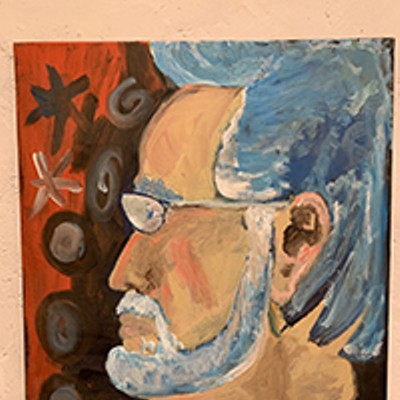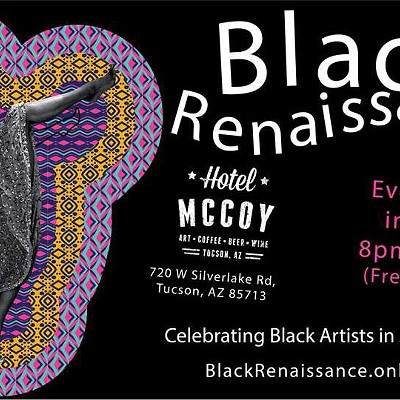An "academic professional" who's been on a year-to-year contract at the museum for more than 14 years, Briggs was notified last week that his contract will not be renewed. Executive Director Charles Guerin, a man whom Briggs helped hire almost four years ago, made the decision and delivered the news in a memo.
According to university policy, academic professionals like Briggs--a category that's distinct from professors and staff--are not entitled to an explanation if their supervisor decides not to renew their contracts, and Guerin gave none. There is no appeal process.
Briggs declined to comment, and Guerin was out of town and unavailable at press time. A call to Guerin's superior, UA Vice President for Research Richard Powell, went unanswered. Assistant Director Diane Hartman said she would not discuss what she called "an internal personnel matter," nor would she speak about Briggs' accomplishments during the last 14 years.
"I'm new. I've been here less than a year," Hartman said.
Briggs began at the museum as curator of collections in 1990, under the late, well-loved director Peter Bermingham. A year before Bermingham's death in 1999, Briggs was promoted to chief curator. He's curated dozens of well-received exhibitions over the years, from the current show of high-art Jasper Johns prints to the stunning retrospective of Bruce McGrew paintings two years ago, to La Cadena Que No Se Corta, a groundbreaking 1996 exhibition of Hispanic folk crafts made in Tucson, co-curated with three others.
Highly visible in the community, Briggs serves on art juries for shows at such places as Pima Community College and Tucson Pima Arts Council and regularly turns up at art openings with his wife, the artist Alice Leora Briggs. He serves on high-level university committees, such as the Strategic Planning and Budget Committee, regularly publishes scholarly articles and has procured thousands of dollars in grant money for the museum. Just three weeks ago, the museum boasted about a $42,000 grant Briggs won from the Samuel H. Kress Foundation.
Like all state institutions, the UAMA is strapped for cash, but the Briggs ouster will not save the museum money. Guerin announced in a staff memo last week that he intends to replace Briggs and will initiate a national search "as soon as possible." Meantime, he wrote, he plans to step into Briggs' shoes.
"Following Peter's departure I will serve as Director/Chief Curator until a replacement is hired," he wrote.
If the UA officials weren't talking about the reasons for the surprise move, the art community was abuzz with the news.
"I find it quite appalling," said artist Dan Leach. "Peter's a bright guy, articulate, devoted. I always liked him."
Julie Anne Plax, associate director of the UA School of Art, said, "It came as a surprise to everybody. We all (in the art department) have such respect for his skills." His scholarship and hands-on know-how are a fine combination in a university setting, she said, noting that Briggs always takes on interns from the art school and "they learn a great deal.
"He's really great to work with as a teacher. I teach 18th-century art history. I'll call Peter and say, 'Can you pull some Piranesi prints?' He'll do it right away and show them to the students. He's cooperative and knowledgeable."
Doug Nickel, director of the Center for Creative Photography since last June, said, "It took me by surprise." It's not unusual for a museum director to clean out and hire his or her own people, he said (as the recent turmoil at the Whitney Museum demonstrates), but it's more likely to happen early on.
Unlike his boss, Guerin--who has a pair of studio art MFAs from Northern Illinois University--Briggs holds a doctorate in art history from the University of Mexico, in pre-Colombian and Native American art.
"Peter has been the intellectual guide to that place ever since Peter Birmingham died," said Alan Huerta, who worked as an assistant preparatory at the museum until Guerin laid him off about two years ago. "He knows about art, and he knows how to handle people. He's successful and knowledgeable. He's a smart guy, tough, fair, honest and straight."
Numerous observers likened the Briggs affair to the surprise firing of Joanne Stuhr as curator of the Tucson Museum of Art last August. While Briggs was not fired--he simply is not having his contract renewed--like Stuhr, he lost his job at the hands of a relative newcomer to the Tucson scene. And Guerin's action further destabilizes a university arts community that has been reeling for years under the drama at the Center for Creative Photography. The center was without a director for three years--following the firing of its director, Terence Pitts, in 2000--and has been without a curator for two years, since Trudy Wilner Stack quit. (Nickel said a search committee is looking for a new curator and he hopes to have one on board by June.)
The move is sure to bring new scrutiny to Guerin as well. Up for his five-year evaluation next year, Guerin has been practically invisible in the arts community since his arrival in July 2000. Hired a year and a half after Bermingham's sudden death, Guerin came to the UAMA after a 14-year stint at the University of Wyoming museum. His chief accomplishment there was getting a new museum funded and constructed. He hired the hot architect Antoine Predock to do the design, and the UA search committee (which ironically included Briggs) hoped he might be able to pull the same thing off in Tucson.
"By hook or by crook, I developed a reputation as someone who works in institutional change," Guerin told the Tucson Weekly in an August 2000 interview.
But four years into Guerin's tenure, a new museum is nowhere on the horizon. The institutional change that he's becoming best known for is discontinuity among his staff. Assistant Director Lee Karpiscak, a longtime UAMA veteran, retired not long after Guerin arrived. (Karpiscak had been a candidate for the directorship that Guerin got.) Lynn Berkowitz moved to Tucson from Pennsylvania to work as education director under Guerin and left within months. During a budget crunch, Guerin laid off the museum's only two minority employees--Huerta and Bayo Ijagbeli, a Nigerian who worked part-time as a curator's assistant. Two years later, there are still no minorities on staff.
Despite all the challenges facing his own museum, Guerin diverted his attention away from UAMA for a year to serve as acting director of the rudderless CCP.
Briggs' departure may also raise questions about the university's practice of allowing scholarly professionals like curators to remain unprotected by continuing status or tenure. (As "content providers," curators could face the same challenges to academic freedom that professors and researchers do.) It may also provoke an inquiry into the governance structure at UAMA, where there is no advisory board to limit the power of the director.
Meanwhile, Briggs is "going to be missed," Huerta said. "He's the type of guy who could apply for a curator job anywhere and get it, but we'd miss him in Tucson."
















